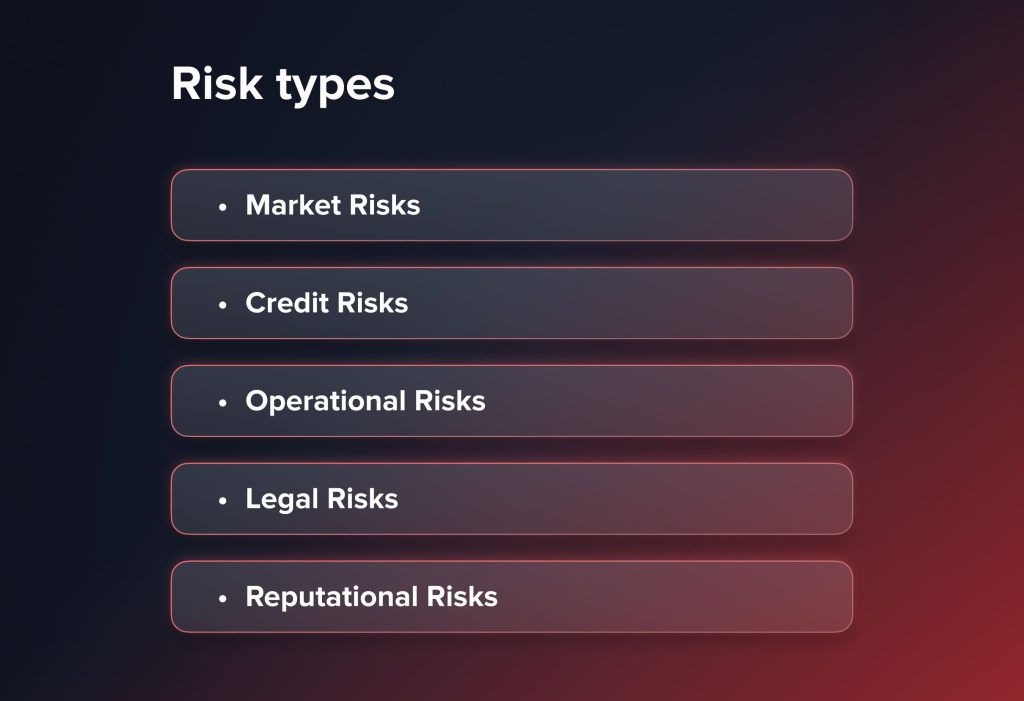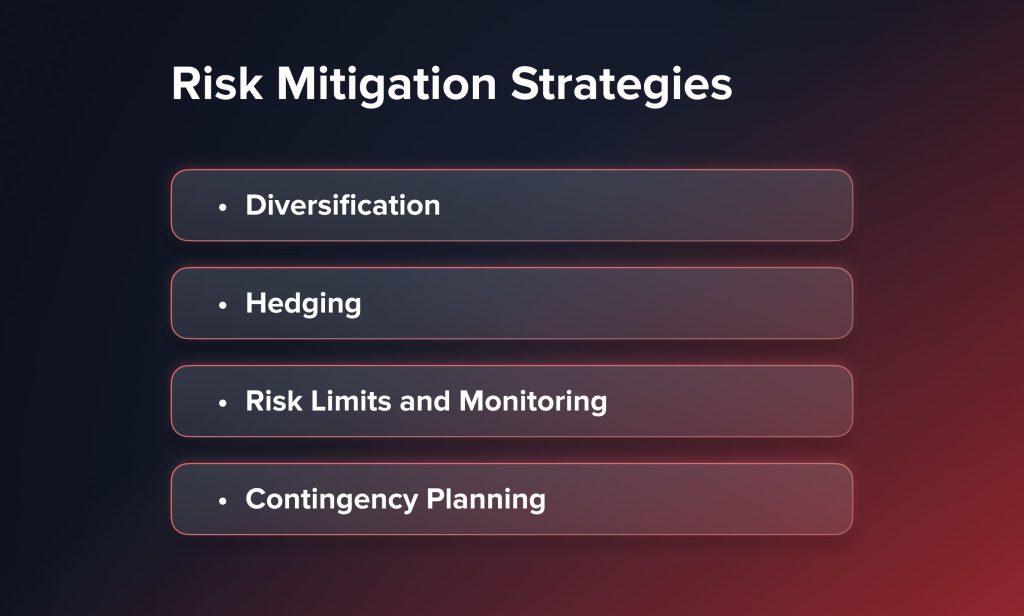
Guía completa para la gestión de riesgos de los corredores
Contenidos
Navegar por las complejidades del mercado financiero exige más que solo una buena percepción de las tendencias y la comprensión de los indicadores económicos; requiere un marco sólido para la gestión de riesgos. Una gestión eficaz del riesgo de los corredores es la base de cualquier empresa de corretaje exitosa, ya que garantiza la identificación, evaluación y mitigación oportuna de las posibles amenazas. Este proceso no solo protege los activos de la empresa, sino que también inspira confianza en los clientes, fundamental para mantener relaciones a largo plazo y la estabilidad del mercado. Al comprender e implementar las mejores prácticas en la gestión del riesgo de los corredores, estos pueden navegar por las aguas volátiles de los mercados financieros con mayor seguridad y éxito.
Identificación y evaluación de riesgos
La piedra angular de una gestión eficaz del riesgo de los corredores es la identificación y evaluación meticulosa de los riesgos. Este paso fundamental implica un análisis exhaustivo y sistemático de todos los riesgos potenciales que podrían afectar negativamente las operaciones de la correduría. Al categorizar estos riesgos en riesgos de mercado, de crédito y operativos, los corredores pueden desarrollar estrategias específicas para gestionar cada tipo de forma eficaz.

Riesgos del mercado
Los riesgos de mercado, los más evidentes y a menudo los más volátiles, se derivan de las fluctuaciones en los precios de los activos, los cambios en la volatilidad del mercado, los tipos de interés y las tendencias económicas generales. Estos riesgos son inherentes a las actividades de trading e inversión. Las fluctuaciones en los precios de los activos pueden deberse a diversos factores, como la publicación de datos económicos, los acontecimientos geopolíticos y los cambios en la confianza de los inversores. Las variaciones de los tipos de interés pueden afectar el coste de los préstamos y la rentabilidad de las inversiones, impactando tanto en los mercados de renta variable como de renta fija. Las tendencias económicas generales, como las recesiones o los periodos de alta inflación, también pueden generar una volatilidad significativa en el mercado. Identificar los riesgos de mercado implica el uso de herramientas analíticas y modelos financieros para predecir posibles movimientos del mercado y cuantificar las posibles pérdidas.
You may also like

Riesgos crediticios
Los riesgos crediticios surgen de la posibilidad de que las contrapartes incumplan sus obligaciones, lo que ocasiona pérdidas financieras a la empresa de corretaje. Estos riesgos son especialmente relevantes en transacciones con crédito, como préstamos, bonos y otras formas de deuda. La evaluación de los riesgos crediticios requiere una evaluación exhaustiva de la salud financiera de la contraparte, incluyendo su historial crediticio, capacidad de pago y estabilidad financiera general. Esta evaluación suele implicar el análisis de los estados financieros, las calificaciones crediticias y la reputación del mercado. El seguimiento continuo de las contrapartes es esencial para detectar tempranamente cualquier indicio de deterioro de la calidad crediticia.
Riesgos operacionales
Los riesgos operativos implican la posibilidad de pérdidas derivadas de procesos y sistemas internos inadecuados o fallidos, errores humanos o eventos externos. Estos riesgos pueden manifestarse de diversas maneras, como fallos del sistema, fraude, filtraciones de datos e ineficiencias de los procesos. Identificar los riesgos operativos requiere un análisis detallado de las operaciones internas, incluyendo la infraestructura de TI, los flujos de trabajo y las acciones de los empleados. Las auditorías y revisiones periódicas de los controles internos ayudan a identificar vulnerabilidades que podrían provocar interrupciones operativas. Los errores humanos, como errores en la introducción de datos o acciones no autorizadas, también se incluyen en esta categoría y requieren programas sólidos de capacitación y monitoreo para mitigarlos.
Riesgos legales
Los riesgos legales surgen de posibles acciones legales, cambios regulatorios o incumplimientos que pueden afectar las operaciones y la estabilidad financiera de la empresa de corretaje. Estos riesgos pueden derivar del incumplimiento de las leyes y regulaciones, como las regulaciones de valores, las leyes de protección de datos y los requisitos contra el lavado de dinero. Los riesgos legales también incluyen posibles demandas o medidas coercitivas adoptadas por los organismos reguladores. Identificar los riesgos legales implica mantenerse informado sobre las regulaciones actuales y futuras, garantizar que los contratos y acuerdos sean legalmente sólidos y exigibles, y contar con un equipo de cumplimiento dedicado a supervisar e implementar los cambios regulatorios necesarios.
Riesgos reputacionales
Los riesgos reputacionales implican un posible daño a la reputación de la correduría como resultado de publicidad negativa, incumplimientos regulatorios o malas experiencias con los clientes. Estos riesgos pueden provocar la pérdida de confianza de los clientes y una disminución en el volumen de negocio. Entre los factores que contribuyen a los riesgos reputacionales se incluyen los escándalos públicos, las quejas de los clientes, las multas regulatorias y la cobertura mediática negativa. Identificar los riesgos reputacionales requiere un monitoreo continuo de la percepción pública mediante herramientas como el seguimiento en redes sociales, encuestas a clientes y software de gestión de la reputación. La retroalimentación de los clientes y las partes interesadas puede proporcionar alertas tempranas sobre problemas que podrían dañar la reputación de la correduría.
Al identificar y evaluar meticulosamente estos riesgos, los corredores pueden desarrollar estrategias específicas para mitigarlos, salvaguardando así sus operaciones y asegurando la estabilidad y el éxito a largo plazo en los mercados financieros.
Estrategias de mitigación de riesgos
Una vez identificados y evaluados los riesgos, es fundamental implementar estrategias eficaces de mitigación de riesgos. Estas estrategias están diseñadas para reducir tanto la probabilidad como el impacto de los riesgos identificados, garantizando así la estabilidad y resiliencia de la empresa de corretaje. A continuación, se presentan algunas de las estrategias de mitigación de riesgos más eficaces.

Diversificación
La diversificación es fundamental para la mitigación de riesgos en el sector de corretaje. Al distribuir las inversiones entre diversas clases de activos, sectores y regiones geográficas, los corredores pueden reducir significativamente el impacto de fluctuaciones adversas en cualquier mercado o activo.
- Diversificación de clases de activosInvertir en una combinación de acciones, bonos, materias primas, bienes raíces y otras clases de activos puede ayudar a equilibrar el riesgo. Por ejemplo, cuando los mercados bursátiles son volátiles, los bonos pueden ofrecer estabilidad. La diversificación dentro de las clases de activos, como la tenencia de varios tipos de bonos (gubernamentales, corporativos, municipales), también puede brindar mayor protección.
- Diversificación sectorialDentro de las clases de activos, distribuir las inversiones entre diferentes sectores (p. ej., tecnología, salud, finanzas) puede proteger contra las recesiones sectoriales. Si el sector tecnológico experimenta una recesión, las inversiones en salud o finanzas podrían seguir teniendo un buen rendimiento. Las estrategias de rotación sectorial, que implican el traslado de inversiones entre sectores según los ciclos económicos, pueden potenciar la diversificación.
- Diversificación geográficaInvertir en diferentes regiones geográficas puede mitigar los riesgos asociados a eventos económicos o políticos específicos de cada país. Por ejemplo, mientras un país puede enfrentar desafíos económicos, otro puede prosperar. Los mercados emergentes pueden ofrecer oportunidades de crecimiento, mientras que los mercados desarrollados pueden brindar estabilidad.
- Vehículos de inversiónEl uso de diversos vehículos de inversión, como fondos mutuos, ETF y fondos indexados, puede ofrecer diversificación dentro de un mismo producto, brindando exposición a una amplia gama de activos con un costo y un esfuerzo de gestión relativamente bajos. Estos vehículos pueden brindar acceso a nichos de mercado o estrategias específicas (por ejemplo, ETF sectoriales, fondos mutuos temáticos) que podrían ser difíciles de alcanzar mediante la inversión directa.
- Diversificación temporalDistribuir las inversiones en diferentes horizontes temporales puede reducir el riesgo de sincronización del mercado. Mediante el promedio del costo en dólares, donde las inversiones se realizan a intervalos regulares, los corredores pueden mitigar el impacto de la volatilidad del mercado en la cartera general.
Cobertura
Cobertura Implica el uso de instrumentos financieros para compensar posibles pérdidas derivadas de fluctuaciones adversas de precios. Una cobertura eficaz requiere un profundo conocimiento de los mercados e instrumentos financieros.
- Opciones: Opciones provide the right, but not the obligation, to buy or sell an asset at a predetermined price. For example, purchasing put options can protect against significant declines in stock prices, as they give the right to sell the stock at a specific price, thus capping potential losses. Call options can be used to lock in purchase prices for assets that are expected to rise.
- Futuros y forwardsEstos contratos obligan al comprador a comprar, o al vendedor a vender, un activo en una fecha y precio futuros predeterminados. Por ejemplo, los corredores pueden protegerse del riesgo cambiario mediante contratos a plazo que fijan los tipos de cambio, protegiéndolos de fluctuaciones cambiarias desfavorables. Los futuros pueden utilizarse para cubrir materias primas, tipos de interés o índices bursátiles.
- Intercambios: Intercambios involve exchanging cash flows or other financial instruments between parties. Interest rate swaps can hedge against changes in interest rates. In contrast, credit default swaps (CDS) can protect against credit risk by transferring the risk of a counterparty default to another party. Currency swaps can manage exchange rate risks in international investments.
- Costos y beneficios de la coberturaEs crucial equilibrar los costos de la cobertura con los beneficios potenciales. Si bien la cobertura puede reducir el riesgo, también implica costos como las primas para opciones o los requisitos de margen para futuros. Los corredores deben evaluar cuidadosamente si el costo de la cobertura justifica la protección que ofrece. Comprender las griegas (Delta, Gamma, Theta, Vega, Rho) en la negociación de opciones puede ayudar a evaluar la rentabilidad de las estrategias de cobertura.
- Cobertura dinámicaAjustar las estrategias de cobertura ante las condiciones cambiantes del mercado puede optimizar la protección. Esto implica revisar y reequilibrar periódicamente las posiciones de cobertura para garantizar su eficacia.
You may also like

Límites de riesgo y seguimiento
Establecer límites de riesgo es esencial para controlar la exposición a diversos riesgos. Estos límites deben estar alineados con la tolerancia al riesgo y la capacidad financiera de la correduría. La monitorización continua garantiza que las exposiciones se mantengan dentro de niveles aceptables.
- Establecer límites de riesgoLos límites de riesgo se pueden establecer en función de diversos criterios, como la clase de activo, el sector, la región geográfica y la exposición individual a la contraparte. Estos límites deben reflejar la tolerancia al riesgo general y los objetivos estratégicos de la empresa de corretaje. Por ejemplo, establecer un porcentaje máximo de la cartera que pueda invertirse en activos de alto riesgo garantiza una exposición al riesgo equilibrada.
- Monitoreo en tiempo realLos sistemas automatizados de gestión de riesgos pueden proporcionar datos y alertas en tiempo real, lo que permite a los corredores tomar medidas oportunas para mitigar los riesgos. Estos sistemas pueden rastrear los movimientos del mercado, la exposición de las contrapartes y el cumplimiento de los límites de riesgo, ofreciendo una visión completa del perfil de riesgo de la empresa. La integración de inteligencia artificial y aprendizaje automático puede mejorar el análisis predictivo y las capacidades de evaluación de riesgos.
- Pruebas de estrés y análisis de escenariosLas pruebas de estrés periódicas y el análisis de escenarios ayudan a garantizar límites de riesgo adecuados en condiciones de mercado extremas. Estas pruebas pueden revelar posibles vulnerabilidades y orientar los ajustes a los límites de riesgo y las estrategias de cobertura. El análisis de escenarios puede incluir eventos hipotéticos como caídas del mercado, recesiones económicas o tensiones geopolíticas.
- Ajustes dinámicosLos límites de riesgo y los procesos de monitoreo deben ser dinámicos, permitiendo ajustes en respuesta a las condiciones cambiantes del mercado, los requisitos regulatorios y el perfil de riesgo cambiante de la correduría. Las prácticas de gestión de riesgos deben revisarse y adaptarse continuamente para mantener un control efectivo. Implementar un panel de control de riesgos que proporcione una visión general en tiempo real de los indicadores clave de riesgo puede facilitar la toma de decisiones rápida.
Planificación de contingencias
Además de la diversificación, la cobertura y el seguimiento, los corredores deben desarrollar planes de contingencia sólidos para abordar posibles eventos de riesgo.
- Planes de gestión de crisisPlanes detallados de gestión de crisis para garantizar que los agentes puedan responder con rapidez y eficacia ante imprevistos. Estos planes deben detallar los procedimientos de comunicación, toma de decisiones y ajustes operativos durante una crisis. La capacitación y los simulacros periódicos garantizan que todo el personal esté familiarizado con los protocolos de gestión de crisis.
- Reservas de liquidezMantener reservas de liquidez adecuadas es esencial para gestionar el estrés financiero. Estas reservas pueden proporcionar el colchón necesario para cubrir pérdidas inesperadas o cubrir las demandas de margen sin interrumpir las operaciones normales. Las estrategias para mejorar la liquidez incluyen mantener una parte de la cartera en activos de alta liquidez y establecer líneas de crédito con instituciones financieras.
- Planificación de la continuidad del negocioLos planes de continuidad del negocio garantizan la continuidad de las funciones críticas durante y después de una interrupción. Esto incluye planes de recuperación ante desastres de TI, plataformas de comercio alternativas y centros de datos de respaldo. Las pruebas y actualizaciones periódicas de los planes de continuidad del negocio garantizan su eficacia y relevancia.
- Estrategias de comunicaciónLa comunicación eficaz en situaciones de crisis con clientes, empleados y organismos reguladores es crucial. Una comunicación transparente y oportuna puede ayudar a gestionar las expectativas y mantener la confianza. Establecer un protocolo de comunicación y designar portavoces puede agilizar este proceso.
Al implementar estas estrategias integrales de mitigación de riesgos, los corredores pueden reducir significativamente su exposición a diversos riesgos, garantizando así la estabilidad y resiliencia de sus operaciones. Una gestión eficaz de riesgos protege los activos de la correduría y genera confianza entre los clientes, impulsando así el éxito a largo plazo en los mercados financieros.
Cumplimiento normativo
Cumplir con los requisitos regulatorios es un aspecto crucial de la gestión de riesgos de los corredores. Las regulaciones están diseñadas para garantizar la integridad del mercado, proteger a los inversores y promover la estabilidad financiera. Los corredores deben mantenerse informados sobre las regulaciones pertinentes y garantizar su cumplimiento para evitar sanciones legales y daños a la reputación.
Mantener registros precisos
Los corredores deben mantener registros precisos y completos de todas las transacciones, interacciones con los clientes y actividades financieras. Estos registros son cruciales para auditorías, revisiones regulatorias y para garantizar la transparencia. Implementar sistemas robustos de registro de datos que se actualicen periódicamente puede ayudar a los corredores a cumplir con estos requisitos de manera eficiente. La digitalización de registros y el uso de soluciones seguras de almacenamiento en la nube pueden mejorar la accesibilidad y la seguridad.
Realizar la debida diligencia
La diligencia debida implica investigar y verificar exhaustivamente los antecedentes, la situación financiera y los objetivos de inversión de los clientes. Este proceso es esencial para prevenir el fraude, el blanqueo de capitales y otras actividades ilícitas. Los corredores deben utilizar herramientas y bases de datos avanzadas de diligencia debida para verificar la información de los clientes. Es posible que se requieran procedimientos de diligencia debida más rigurosos, que incluyan una investigación más exhaustiva y un seguimiento continuo, para clientes o transacciones de alto riesgo.
Procedimientos contra el lavado de dinero y de Conozca a su cliente
Implementar procedimientos de prevención del lavado de dinero y de conocimiento del cliente (KYC) es obligatorio para prevenir actividades ilícitas. Los programas de prevención del lavado de dinero deben incluir la evaluación de riesgos, la identificación de clientes, la supervisión de transacciones y la denuncia de actividades sospechosas a las autoridades competentes. El KYC implica verificar la identidad de los clientes, comprender sus actividades financieras y evaluar los posibles riesgos. La actualización periódica de la información del cliente y la supervisión continua son cruciales para un cumplimiento eficaz de las normas de prevención del lavado de dinero y de conocimiento del cliente (KYC). Capacitar al personal sobre los requisitos de KYC y de prevención del lavado de dinero garantiza el cumplimiento constante de los procedimientos.
Controles y auditorías de cumplimiento
Las auditorías internas y externas periódicas son esenciales para identificar y corregir problemas de incumplimiento. Las auditorías internas deben realizarse periódicamente para revisar el cumplimiento de los requisitos regulatorios, las políticas internas y las prácticas de gestión de riesgos. Las auditorías externas realizadas por auditores independientes permiten evaluar objetivamente el estado de cumplimiento de la correduría. Implementar las recomendaciones de auditoría con prontitud y eficacia puede mejorar el cumplimiento y mitigar los riesgos.
Conclusión
En conclusión, una gestión eficaz del riesgo de los corredores implica un enfoque sistemático para identificar, evaluar y mitigar los riesgos. Al adoptar las mejores prácticas y mejorar continuamente sus estrategias de gestión de riesgos, los corredores pueden salvaguardar sus operaciones, proteger a sus clientes y alcanzar un éxito sostenible en los mercados financieros.
Actualizado:
19 de diciembre de 2024



